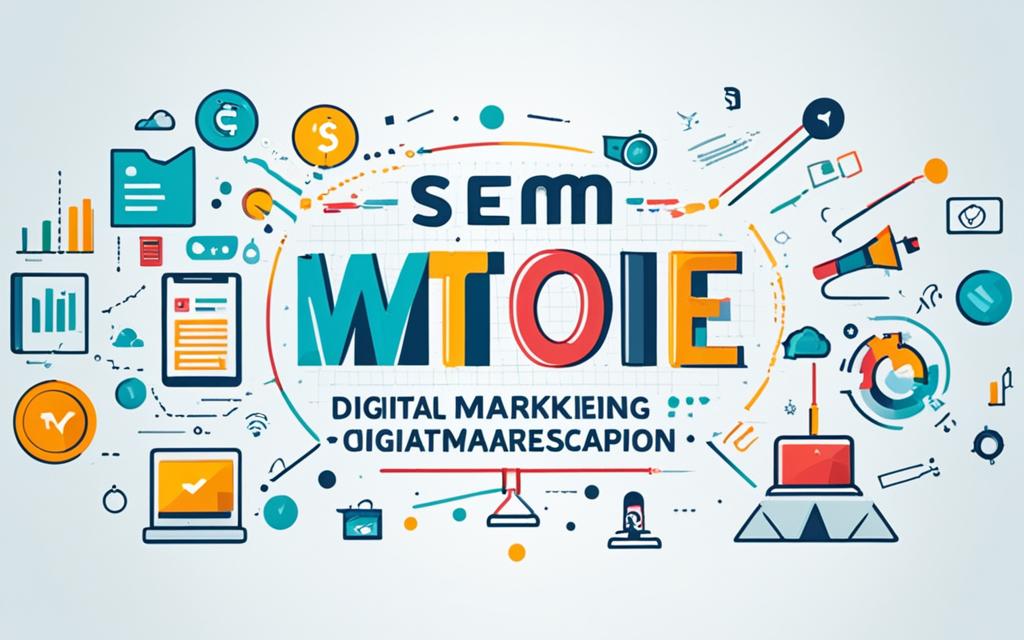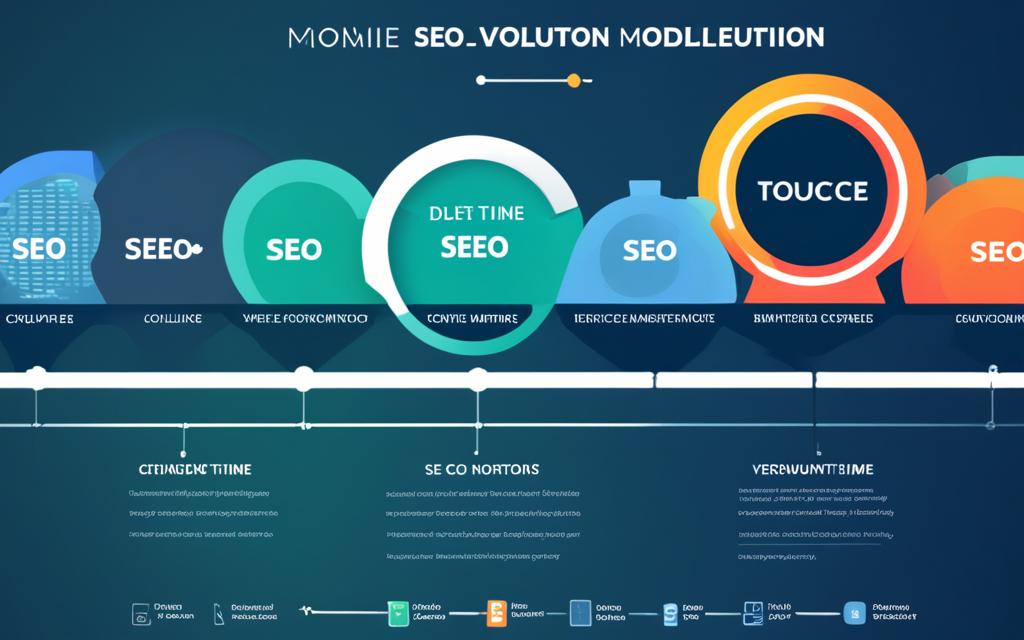Welcome to the world of digital marketing, where competition is fierce and attention spans are short. In this fast-paced landscape, it’s crucial to stay ahead of the game and reach your target audience effectively. That’s where SEM (Search Engine Marketing) comes in.
SEM plays a pivotal role in your overall digital marketing strategy, helping you elevate your brand, boost website traffic, and increase conversions. By leveraging SEM, you can drive targeted traffic to your website through strategic ad campaigns that appear in search engine results pages (SERPs).
With SEM, you have the power to capture the attention of potential customers who are actively searching for products or services that align with your offerings. By bidding on relevant keywords and creating compelling ads, you can position your brand at the top of search engine results, ensuring maximum visibility and driving qualified traffic to your website.
Unlike other forms of marketing that rely on broad reach, SEM allows you to target specific demographics, locations, and even time frames. This level of precision ensures that your ads are seen by the right people, at the right time, maximizing your chances of generating meaningful interactions and conversions.
Furthermore, SEM provides valuable insights and data that allow you to optimize your campaigns and refine your marketing strategy. By tracking metrics such as click-through rates, conversion rates, and cost per acquisition, you can make data-driven decisions to improve your ROI and continually optimize your ad performance.
In this article, we will dive deeper into the world of SEM, exploring its benefits, keyword bidding strategies, ad creation techniques, landing page optimization, integration with SEO, and cost management techniques. By the end, you’ll have a comprehensive understanding of how SEM can supercharge your digital marketing efforts and help you achieve your business goals.
Understanding SEM and Its Benefits
When it comes to digital marketing, Understanding SEM (Search Engine Marketing) is crucial for your business’s success. SEM involves promoting your website through paid advertising efforts on search engine result pages (SERPs), such as Google Ads. By investing in SEM, you can reach your target audience more effectively and achieve your marketing goals.
One of the main Benefits of SEM for Your Business is its ability to generate targeted leads. With SEM, you can create tailored advertisements that appear when users search for specific keywords related to your products or services. This precision targeting ensures that your ads are seen by people actively interested in what you offer, increasing the likelihood of conversion.
Another advantage of SEM is its ability to drive website traffic. By strategically bidding on relevant keywords, you can secure top positions on SERPs, making it easier for potential customers to discover your website. This increased visibility leads to higher click-through rates and more visits to your site, ultimately boosting brand exposure and customer engagement.
Moreover, SEM allows you to improve your online visibility, which is especially important in today’s digital landscape. By appearing prominently on SERPs, you establish your brand as a credible and trustworthy option in the minds of consumers. This increased visibility not only helps you gain an edge over your competitors but also enhances your overall brand reputation.
In summary, understanding SEM is crucial for your business’s digital marketing strategy. By leveraging the benefits of SEM, you can generate targeted leads, drive website traffic, and improve your online visibility. Stay tuned to learn more about effective keyword bidding strategies and creating compelling ads in the next section.
Keyword Bidding Strategies and Creating Effective Ads
In order to make the most out of your SEM campaigns, it’s crucial to understand the importance of keyword bidding strategies and creating effective ads. By implementing proven tactics, you can optimize your budget allocation and attract the right audience to achieve your marketing goals.
The Power of Keyword Bidding Strategies
Keyword bidding strategies play a significant role in determining the success of your SEM campaigns. An effective strategy involves careful research and analysis to identify the keywords that are most relevant to your products or services. By targeting the right keywords, you can increase your visibility in search engine results pages (SERPs) and drive qualified traffic to your website.
One popular keyword bidding strategy is the modified broad match approach. This strategy allows you to reach a wider audience without sacrificing precision. By placing a “+” symbol in front of certain words within a keyword, you can ensure that your ad is triggered by searches that include those specific terms. For example, if you have a shoe store and use the keyword “+running +shoes,” your ad may appear for searches like “best running shoes” or “affordable running shoes.”
Another effective strategy is geo-targeting your keywords. This involves specifying the locations where you want your ads to appear. By targeting specific regions or even cities, you can focus your budget on reaching customers who are more likely to convert. For example, if you run a local bakery, you can bid on keywords related to your products and limit the visibility of your ads to your target market.
Creating Effective Ads
Alongside keyword bidding strategies, creating compelling and effective ads is crucial for SEM success. Here are some tips to craft ads that grab attention and encourage clicks:
- Be concise: Use concise and powerful language to communicate your value proposition quickly. Highlight the unique features or benefits of your products or services.
- Include a strong call-to-action: Encourage users to take action by including a clear call-to-action (CTA) in your ad copy. Use words like “buy now,” “sign up,” or “learn more” to prompt engagement.
- Use relevant ad extensions: Ad extensions provide additional information about your business or offer, increasing the visibility and effectiveness of your ads. Utilize extensions like sitelinks, call extensions, or structured snippets to enhance your ad’s performance.
- Optimize for mobile: With the majority of searches now happening on mobile devices, it’s essential to create ads that are mobile-friendly. Ensure that your ad copy and landing page are optimized for smaller screens and provide a seamless user experience.
By incorporating these strategies into your SEM campaigns, you can improve your ad performance, increase click-through rates, and ultimately drive more conversions. Remember to regularly monitor and adjust your keyword bids and ad copy based on performance data to continuously optimize your results.
Landing Page Optimization and Tracking SEM Success
Optimizing your landing pages is a critical aspect of your digital marketing strategy. It involves creating a seamless user experience and maximizing conversions. By focusing on landing page optimization, you can enhance the effectiveness of your SEM campaigns and drive more qualified traffic to your website.
When it comes to landing page optimization, there are several key elements to consider. One important factor is the relevance of your landing page to the ad or keyword that brought the user to your site. Ensuring that your landing page aligns closely with the user’s search intent increases the chances of conversion.
Another aspect to focus on is the design and layout of your landing page. A clean and visually appealing design, coupled with intuitive navigation, can significantly improve user engagement. By optimizing the placement of your call-to-action buttons and strategically using compelling headlines and persuasive copy, you can guide visitors towards taking the desired action, whether it’s making a purchase, filling out a form, or subscribing to your newsletter.
Tracking and measuring the success of your SEM campaigns is crucial to understanding their performance and making data-driven decisions. By utilizing tracking tools and analytics software, you can gain valuable insights into user behavior, conversion rates, and other key metrics. This data allows you to identify areas for improvement, refine your strategies, and allocate your resources effectively.
“Landing page optimization is a continuous process. By testing different elements, monitoring user behavior, and making data-driven adjustments, you can refine your landing pages and increase their conversion rates over time.” – John Smith, Marketing Director at XYZ Company
To track the success of your SEM campaigns, you can use various tracking methods such as conversion tracking, click-through rate (CTR) analysis, and conversion attribution. These tools help you measure the impact of your ads and keywords, identify high-performing campaigns, and optimize your budget allocation.
Remember, landing page optimization and tracking SEM success go hand in hand. By continually improving your landing pages and monitoring their performance, you can achieve better results from your SEM efforts and maximize your return on investment.
Key Takeaways:
- Landing page optimization plays a vital role in enhancing user experience and improving conversion rates.
- Relevance, design, and layout are key factors in landing page optimization.
- Tracking tools and analytics software help measure the success of SEM campaigns and provide insights for optimization.
- Continuous testing and data-driven adjustments are essential for improving landing page performance.
Integrating SEM with SEO and Cost Management Techniques
When it comes to digital marketing, integrating your SEM (Search Engine Marketing) efforts with your SEO (Search Engine Optimization) strategy can yield remarkable results. By combining these two powerful tactics, you can maximize your online visibility, drive targeted traffic to your website, and ultimately increase conversions. Let’s explore how you can harness the synergy between SEM and SEO for optimal outcomes.
First and foremost, it’s essential to understand that SEM and SEO serve different purposes but work in harmony. SEM focuses on paid advertising to achieve immediate visibility on search engine results pages (SERPs), whereas SEO aims to improve organic rankings over time. By leveraging both strategies, you establish a comprehensive online presence that captures potential customers from various touchpoints in their buying journey.
Integrating SEM with SEO creates a formidable digital marketing strategy that amplifies your brand’s visibility and drives qualified traffic to your website.
One of the key advantages of integrating SEM with SEO is the ability to uncover valuable keyword insights. SEM campaigns provide real-time data on user search behavior, allowing you to identify high-performing keywords that resonate with your target audience. This information can then inform your organic SEO efforts, enabling you to optimize your website content and metadata for improved search rankings.
Furthermore, aligning SEM with SEO enhances your cost management techniques, ensuring you get the most out of your digital marketing budget. By analyzing SEM campaign data, you can identify top-performing keywords and allocate more resources towards organic SEO optimization for those specific terms, reducing your reliance on expensive paid advertising in the long run.
In addition to keyword integration, integrating SEM with SEO also allows for cross-channel optimization. By analyzing SEM and SEO data together, you can identify keywords and content that perform well across multiple channels, such as search engines and social media platforms. This holistic approach enables you to fine-tune your messaging and target your audience more effectively, regardless of the platform they’re using.
Finally, cost management techniques are instrumental in running successful SEM campaigns. By strategically managing your keyword bids, budget allocation, and ad placements, you can optimize your return on investment (ROI) and maximize the impact of your SEM efforts. Regularly monitoring and adjusting your campaigns based on performance metrics ensures that you are capitalizing on the most effective strategies and minimizing wasted spend.
Cost Management Techniques
Effective cost management techniques play a vital role in getting the most value out of your SEM campaigns. Here are a few strategies to keep in mind:
- Set realistic goals and budget: Clearly define your campaign objectives and allocate your budget accordingly, ensuring that you have sufficient resources to achieve your desired outcomes.
- Optimize your keywords: Continuously monitor and adjust your keyword bids to find the optimal balance between cost and performance. Focus on relevant, high-converting keywords to maximize your ROI.
- Refine your audience targeting: Narrow down your audience targeting to reach the most valuable prospects. Utilize demographic, geographic, and behavioral targeting options to optimize your ad spend.
- Test and optimize ad creatives: Conduct A/B testing on your ad creatives to identify the most compelling and effective messaging. Continuously refine and optimize your ads based on performance metrics.
By integrating SEM with SEO and implementing cost management techniques, you can create a dynamic digital marketing strategy that drives measurable results. Remember, the key is to strike a balance between paid and organic tactics, leveraging data-driven insights to optimize your campaigns and maximize your ROI. With the right approach, your brand can achieve long-term success in the ever-evolving digital landscape.
Conclusion
In today’s digital landscape, the future trends in SEM are rapidly evolving. To stay ahead of the competition and maximize your business growth, it is vital to adapt and embrace these trends. SEM has proven to be a powerful tool in your digital marketing strategy, providing numerous benefits and driving success.
Case studies of SEM success stories demonstrate how businesses have achieved significant results by leveraging SEM. Companies like Apple, Nike, and Coca-Cola have utilized SEM to enhance their online presence, increase brand visibility, and drive targeted traffic to their websites.
As technology advances and consumer behavior continues to evolve, future trends in SEM will focus on automation, artificial intelligence, and voice search. Understanding and incorporating these trends into your SEM strategy will enable you to reach your target audience effectively and drive measurable results.
By integrating SEM with other digital marketing techniques, such as SEO and cost management, you can optimize your marketing efforts and achieve even greater success. By monitoring and tracking your SEM campaigns’ performance through landing page optimization and analytics, you can continuously refine and improve your strategy.
Remember, the digital landscape is ever-changing, and it is crucial to stay informed and adapt accordingly. Embrace the future trends in SEM and leverage case studies of SEM success to fuel your business growth and stay ahead in the digital marketing game.







